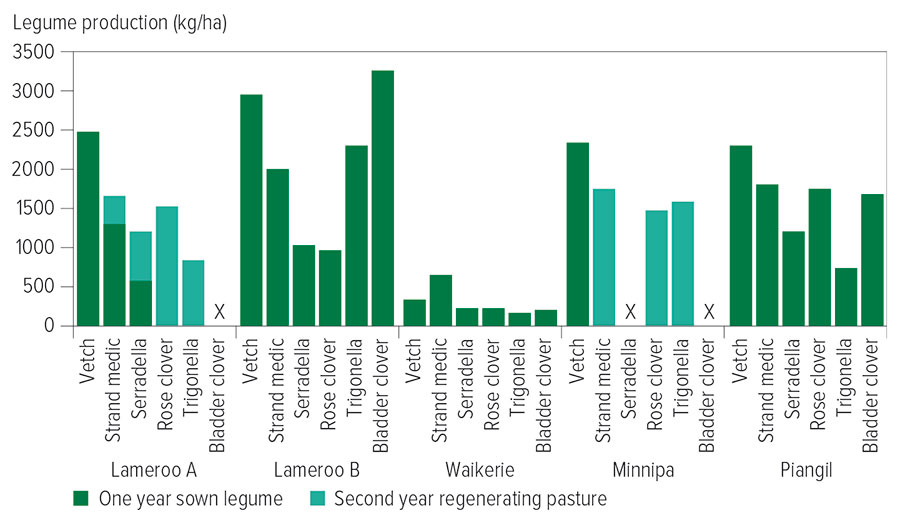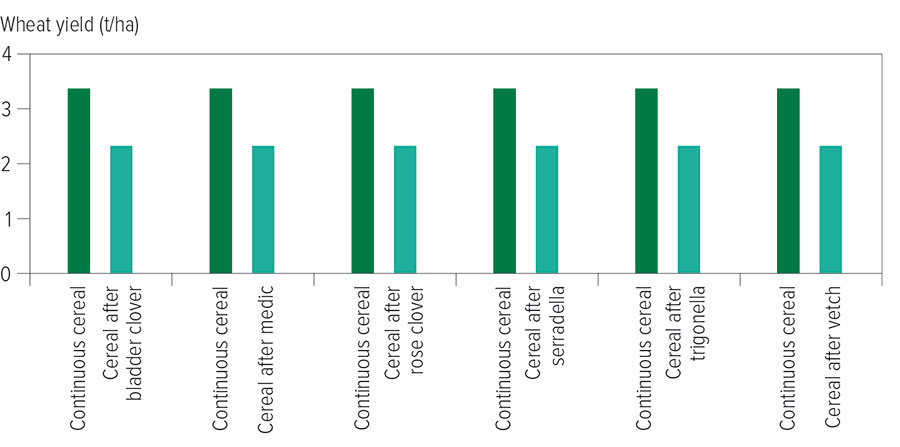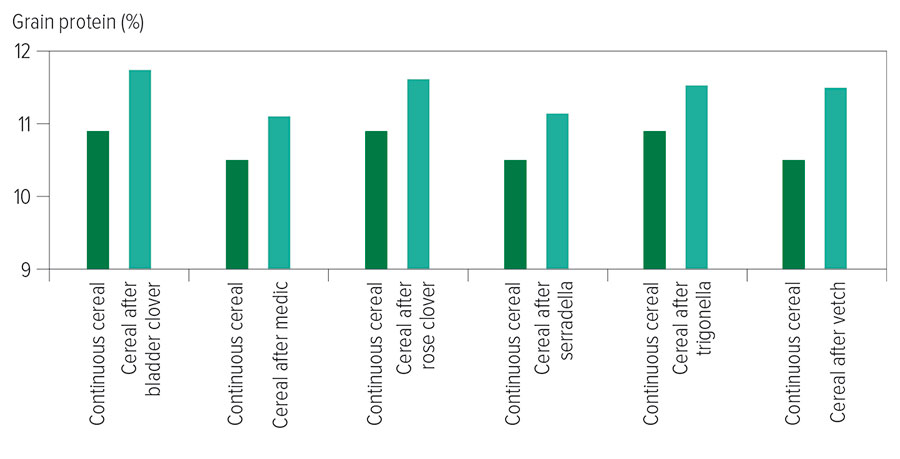To inform decisions about adopting new legume pasture species, a national project has been quantifying the benefits provided by these pasture species in regional mixed farm contexts in the low-rainfall zones of South Australia and Victoria.
The Dryland Legume Pasture Systems project southern component led by the South Australian Research and Development Institute and CSIRO have evaluated the rotational benefit of legume pasture species traditionally grown in the region. These have included medic (Medicago littoralis, cv. Seraph) and vetch (Vicia sativa, cv. Studenica). A number of ‘alternative’ legume species were also investigated, including Trigonella balansae (acc. APG5045), bladder clover (Trifolium spumosum, cv. Bartolo), rose clover (Trifolium hirtum, cv. SARDI Rose) and French serradella (Ornithopus sativus, cv. Margurita).
Substantial increases in cereal yield and grain protein were measured after medic pasture or brown-manured vetch, compared to continuous cereal crops. Despite the costs of establishment, gains in subsequent crop yields alone can provide substantial return on investment, which are increased when accounting for grazing value and in the case of medic, the set-up of a pasture seedbank.
On neutral/alkaline sandy loam soils, vetch remains the best option where a sown legume ley of one-year duration is preferred. Where a self-regenerating pasture is preferred, annual medics were most commonly the best option.
About the trials
Four pasture/crop rotation trials were established from 2018 to 2021, targeting neutral and alkaline sandy loams receiving less than 400 millimetres of rainfall across SA and Victoria (Table 1). Sites were cropped with wheat in 2020 (and 2021 in Lameroo), following either vetch, or one year of sown pasture, or two years of pasture sown in 2018 and regenerated in 2019.
Table 1: Soil type, rainfall and rotation sequence at the four sites in the southern DLPS study.
Location | Site information | Rotation sequence and legumes |
|---|---|---|
Lameroo SA A | Sand over loam pH (0-10 cm) = 7 Mean annual rainfall 381mm 2019 annual rainfall 254mm 2020 annual rainfall 457mm | Pasture/pasture/wheat/pasture Wheat/pasture/wheat/pasture Pasture/wheat Studenica vetch (BM), Seraph medic, SARDI rose clover, trigonella, Margurita serradella |
Lameroo SA B | As above | Pasture/wheat Studenica vetch (BM), Seraph medic, SARDI rose clover, trigonella, Margurita serradella |
Waikerie SA | Red sand pH (0-10 cm) = 8 Mean annual rainfall 253mm 2019 annual rainfall 119mm 2020 annual rainfall 326mm | Pasture/wheat/pasture Studenica vetch (BM), Seraph medic, SARDI rose clover, trigonella, Margurita serradella, bladder clover |
Minnipa SA | Red sandy loam pH (0-10 cm) = 8.4 Mean annual rainfall 324mm 2019 annual rainfall 254mm 2020 annual rainfall 315mm | Pasture/grazed pasture/wheat/grazed pasture Volga vetch, Seraph medic, SARDI rose clover, trigonella, Harbinger medic |
Piangil Vic | Red loamy sand pH (0-10 cm) = 7.4 Mean annual rainfall 330mm 2019 annual rainfall 211mm 2020 annual rainfall= 315mm | Pasture, wheat, pasture Studenica vetch (BM), Seraph medic, SARDI rose clover, trigonella, Margurita serradella, Bartolo bladder clover |
Source: SARDI
Two-year regenerated pasture treatments were only included at Lameroo and Minnipa. The Minnipa site included large plots that were grazed by sheep. Legume break effects on following wheat grain yield, protein and available soil nitrogen were determined.
The amount of dry matter produced by the various legumes at each site is shown in Figure 1. Vetch consistently produced high dry matter over all sites, while legume production at the Waikerie site was curtailed by low rainfall in the 2019 establishment year.
Figure 1: Dry matter production by legume species in 2019 over five sites in South Australia and Victoria. X not included at site.

Source: SARDI
The mean break effect from a one-year pasture was substantial, producing an additional 0.65 tonnes per hectare of grain yield. Wheat yield response was positive for all legumes, in the range of +24 per cent for bladder clover to +53 per cent for vetch (Figure 2).
Figure 2: Mean wheat yield response in 2020 following different single year legume phases across four sites in South Australia (excluding Minnipa) and Victoria.

Source: SARDI
Wheat grain protein levels shown in Figure 3 also increased following a one year legume phase, on average from 10.5 to 11.7 per cent, for all legume species (Figure 3).
Results following the two-year pasture phase at Lameroo and Minnipa varied. At Lameroo, benefits were greater than Minnipa. Wheat yield after two years of medic increased by 2.9t/ha, compared to the continuous cereal treatment. At Minnipa, wheat yield did not increase; however, grain protein increased from 10.2 to 12 per cent.
Figure 3: Mean wheat grain protein in 2020 following different one year legume phases across four sites in South Australia (excl. Minnipa) and Victoria. The two Lameroo sites received a total (sowing + in crop N) of 35 N kg/ha, Piangil (sowing + in crop N) 30 N, whilst Waikerie only 5 kg/ha of N at sowing, with no topdress.
 Source: SARDI
Source: SARDI
After a one-year legume phase, available soil nitrogen preceding the wheat crop was increased on average by 36kg/ha.
Cereal yield responses at Lameroo in 2020 were attributed to increased nitrogen supply (including nitrogen fixation, Table 2) in the legume treatments that contributed to greater head number per square metre, harvest index and grain weight, along with reduced disease pressure.
Table 2: Nitrogen fixation from one and two-year legume phases in Lameroo, SA
2019 Treatment | N fixation in 2018 (kg/ha) | N fixation in 2019 (kg/ha) |
|---|---|---|
Rose Clover – 2 years | 20 | 25 |
Medic | 29 | |
Medic – 2 years | 24 | 44 |
Serradella | 7 | |
Serradella – 2 years | 6 | 25 |
Trigonella – 2 years | 14 | 17 |
Vetch | 46 | |
P-value | <0.001 | 0.004 |
LSD | 5 | 20 |
Source: CSIRO
Vetch remains the best option on neutral alkaline soils in SA and Victoria, where a sown legume ley of one-year duration is preferred.
Among the pasture legume options, Seraph medic was the most productive overall, producing 1423kg/ha in the year of establishment and 1680kg/ha in regenerating swards. But, just as important, it has been the only treatment to consistently regenerate after the cereal crop, averaging about 500 plants per square metre.
There was not a large difference between the newly established pasture legumes in terms of the yield and protein boosts to the subsequent cereal crop. However, greater differences will likely accrue after future pasture phases due to varying ability to regenerate from a seedbank.
In the typically nitrogen-hungry Mallee cropping environment, it is possible for the yield gains in the crops that follow a pasture legume establishment phase to drive a substantial return on investment. With successful new seedbank establishment there is then the major additional value of low-cost legume establishment and livestock production from future pasture phases.
This research was part of the national Dryland Legume Pasture Systems project supported by the Australian Government Department of Agriculture, Water and Environment (DAWE) Rural R&D for Profit program and the Grains Research & Development Corporation, Meat & Livestock Australia and Australian Wool Innovation.
More information: Dr Bonnie Flohr, 0475 982 678, bonnie.flohr@csiro.au
Read more: Resilient pastures for low rainfall mixed farms- crop and system benefits provided by legumes.

























































